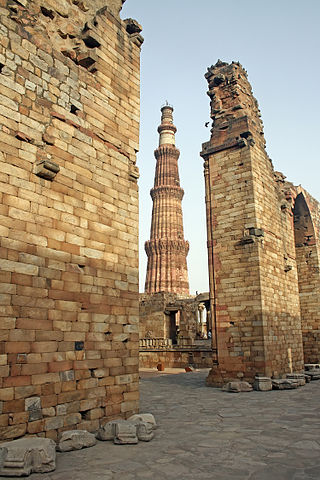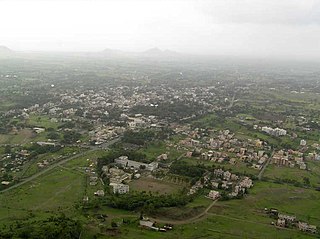
The Qutb Minar complex are monuments and buildings from the Delhi Sultanate at Mehrauli in Delhi, India. Construction of the Qutub Minar "victory tower" in the complex, named after the religious figure Sufi Saint Khwaja Qutbuddin Bakhtiar Kaki, was begun by Qutb-ud-din Aibak, who later became the first Sultan of Delhi of the Mamluk dynasty. It was continued by his successor Iltutmish, and finally completed much later by Firoz Shah Tughlaq, a Sultan of Delhi from the Tughlaq dynasty (1320-1412) in 1368 AD. The Qubbat-ul-Islam Mosque, later corrupted into Quwwat-ul Islam, stands next to the Qutb Minar.

Mughal architecture is the type of Indo-Islamic architecture developed by the Mughals in the 16th, 17th and 18th centuries throughout the ever-changing extent of their empire in the Indian subcontinent. It developed from the architectural styles of earlier Muslim dynasties in India and from Iranian and Central Asian architectural traditions, particularly Timurid architecture. It also further incorporated and syncretized influences from wider Indian architecture, especially during the reign of Akbar. Mughal buildings have a uniform pattern of structure and character, including large bulbous domes, slender minarets at the corners, massive halls, large vaulted gateways, and delicate ornamentation; examples of the style can be found in modern-day Afghanistan, Bangladesh, India and Pakistan.

The Archaeological Survey of India (ASI) is an Indian government agency that is responsible for archaeological research and the conservation and preservation of cultural historical monuments in the country. It was founded in 1861 by Alexander Cunningham who also became its first Director-General.
The Mazagaon Fort was a British fort in Mazagaon, Bombay, in the Indian state of Maharashtra, built around 1680. The fort was razed by the Muslim Koli general, Yakut Khan in June 1690. The fort was located at the present-day Joseph Baptista Gardens, atop Bhandarwada Hill outside the Dockyard Road railway station.
Murud-Janjira is the local name of a famous fort and tourist spot situated on an island just off the coastal town of Murud, in the Raigad district of Maharashtra, India.

Junnar is a city in the Pune district of the Indian state of Maharashtra. The city has history dating back to the first millennium. The nearby fort of Shivneri was the birthplace of Maratha king Chhatrapati Shivaji Maharaj, the founder of the Maratha Empire. Junnar was declared the first tourism taluka in Pune district by the government of Maharashtra on 9 January 2018.

The Sidi Saiyyed Mosque, popularly known as Sidi Saiyyid ni Jali locally, built in 1572–73 AD, is one of the most famous mosques of Ahmedabad, a city in the state of Gujarat, India. The mosque was built by Sidi Sayyad, a Habshi nobleman, in 1572-73.
Murud is a town and a municipal council in Raigad district in the Indian state of Maharashtra. Situated at a distance of 150 km (93 mi) from Mumbai, Murud is a tourist destination. The Palace of Nawab is located in Murud. The palace was built in 1885 for administration purposes. The palace is still owned by the descendants of the Nawab and is a private property.
Mercenaries in India were fighters, primarily peasants, who came from India and abroad, to fight for local rulers in India in the medieval period. This mercenary work became an important source of income for some communities.
Qasim Yakut Khan also known as Yakut Shaikhji, Yakub Khan and Sidi Yaqub was a naval Admiral and administrator of Janjira Fort who first served under Bijapur Sultanate and later under the Mughal Empire.
Jahan-e-Khusrau is an annual three-day sufi music festival held in New Delhi, India to commemorate the death anniversary of the saint Amir Khusrau.

The Sachin State was a princely state belonging to the Surat Agency, former Khandesh Agency, of the Bombay Presidency during the era of the British Raj. Its capital was in Sachin, the southernmost town of present-day Surat district of Gujarat State.
Rander is a town in Surat district in the state of Gujarat, India. Located on the bank of the Tapti River, it is 2 kilometres (1.2 mi) from the city of Surat.

Persian Inscriptions on Indian Monuments is a book written in Persian by Dr Ali Asghar Hekmat E Shirazi and published in 1956 and 1958 and 2013. New edition contains the Persian texts of more than 200 epigraphical inscriptions found on historical monuments in India, many of which are currently listed as national heritage sites or registered as UNESCO world heritage, published in Persian; an English edition is also being printed.
Ghulam Yazdani, OBE was an Indian archaeologist who was one of the founders of the Archaeological Department during the colonial era reign of Nizam of Hyderabad. He also edited the Arabic and Persian Supplement of Epigraphia Indica from 1913 to 1940. He was instrumental in surveying and documenting Islamic, Buddhist, Hindu and Jain sites in the Hyderabad state, including major mosques in the region, the caves at Ajanta, Ellora caves, Alampur group of temples, Ramappa Temple, Bidar fort, and Daulatabad Fort, among many others.

Janjira State was a princely state in India during the British Raj. Its rulers were a Siddi dynasty of Habesha descent and the state was under the suzerainty of the Bombay Presidency.
Udaipur is a town in the Indian state of Madhya Pradesh near Ganj Basoda. It is the site of a well-preserved Śiva temple, a monument of national importance protected by the Archaeological Survey of India.

Sayed Jamaluddin Mosque is a former mosque and archaeological site located in the ancient city of Saptagram in Hooghly district, West Bengal. The mosque was built during the reign of the Bengali sultan Nasiruddin Nasrat Shah.

The Tyabji family, also known as Tyabji-Hydari,Tyabji-Fyzee, and Tyabji-Futehally family, consists of Mullah Tyab Ali and his descendants. The Tyabji family has gained fame for its exhaustive involvement in India's independence movement with individuals being prominent politicians, diplomats, academics, scientists, activists, and athletes. Other members gained prominence for their roles in India's Navy and Air Force and contribution to Indian film and fine art. Individuals within the Tyabji family belong to the Indian royal families of the Nizam of Hyderabad, the Nawab of Bengal, Raja of Wanaparthy, and the Nawab of Janjira. "The Tagores and the Tyabjis are the rarities for India and they are her friends" - Mahatma Gandhi.











